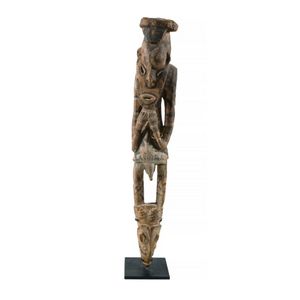Chenghua Period Cast-Iron Guanyin Statue with Inscription
You must be a subscriber, and be logged in to view price and dealer details.
Subscribe Now to view actual auction price for this item
When you subscribe, you have the option of setting the currency in which to display prices to $Au, $US, $NZ or Stg.
- Ming Dynasty - The Ming Dynasty was a ruling dynasty of China from 1368 to 1644. It succeeded the Yuan Dynasty and preceded the Qing Dynasty. The Ming Dynasty was established by Zhu Yuanzhang, a former Buddhist monk who became a rebel leader and eventually overthrew the Mongol Yuan Dynasty. During the Ming Dynasty, China experienced a period of relative stability and prosperity. The government was centralized and bureaucratic, with the emperor at the top of the hierarchy. The Ming Dynasty is known for its cultural achievements, including the development of porcelain, the invention of movable type printing, and the construction of the Great Wall of China.
- Embossed / Repousse - Embossing, also known as repousse, is the technique of decorating metal with raised designs, by pressing or beating out the design from the reverse side of the object.It is the opposite of chasing, where the decoration is applied from the front. An embossed or repoussed object may have chasing applied to finish off the design.
This item has been included into following indexes:
- Chinese antiquities by dynasty - Ming Dynasty 1,230
- Oriental deities, other materials
Visually similar items

A pair of of bronze seated figures of Lorenzo and Giuliano de? Medici, after Michelangelo, from the Medici Chapels, Florence, French, 19th century. 44 cm high

A European polychrome carved figure of Christ, Ostentatio Vulnerum, 17th/18th century, the gilded and polychrome painted carved figure depicted Christ after resurrection showing the five holy wounds, 37 cm high

A large carved wood sculpture of a chef, French circa 1900, 100 cm high

Rare ancestor figure. Yuat river, East Sepik Province, New Guinea. Late 19th, early 20th century. Wood with natural ochres.The addition of a carved hat, does put this figure into a period around the time of the German colonial administration, as it obvious
